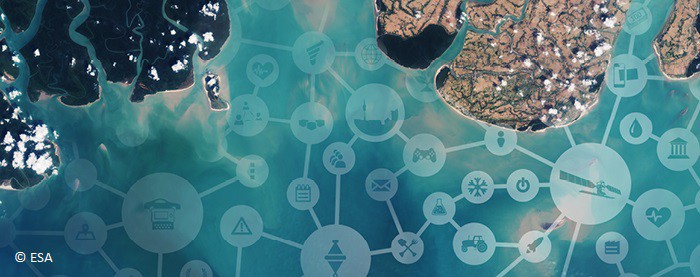“Winning the Copernicus Masters gave us, Astrosat, the opportunity to obtain big business and become a key partner of international aerospace leaders.” Steve Lee, CEO Astrosat.
How did Astrosat become an established player of the space industry, concluding multi-million Euro contracts? This blog post is not an ordinary “from rags to riches” story. This one goes far beyond rising from poverty to wealth. It focuses on how three future-oriented startups participated in an innovation competition – the Copernicus Masters – with ground-breaking ideas using Earth observation (EO) data. In addition, it highlights how they benefitted from the major increase in visibility and awareness through Europe’s leading EO competition. And last but not least: how thereafter they turned their cases into prospering business, providing benefits for society and economy alike.
From Copernicus Masters Participant to Partner
Today, Astrosat is an idea powerhouse that specialises in using satellite data to create services and products that can be used commercially across a broad spectrum of industries. On its way to success, Astrosat started out as Copernicus Masters participant. Its visibility got boosted by winning the DLR Environmental Challenge 2012 with ThermCERT – a system focusing on the demand of improved energy efficiency of houses and buildings, by using infrared Sentinel satellite images and merging them with available ground-based data. In 2013, the Scotland-based startup won the Astrium Radar Challenge with WaveCERT – a system providing vital remote (space-based) modelling, which allows for prediction, monitoring and surveying of tidal and wave potential anywhere in the world. And these were just two prizes that Astrosat took home.
Within no time Astrosat grew into an established company in the space sector. Last year, Astrosat hosted its own Copernicus Master Challenge and awarded SCAMPER – safeguarding a EUR 6 billion global food resource from space – as the winner.
This year’s Copernicus Masters Astrosat Challenge specifically looked for new applications that can be added into its RAPID platform, the Recovery and Protection in Disaster system. It will be exciting to see who will be presented as the winner of this Challenge live on stage on 7 November in Tallinn, Estonia, during the Awards Ceremony at the European Space Week.
First Satellite-Based Online Search Engine for New Construction Projects
Speaking of awards, the following startup was awarded the Copernicus Masters Overall Winner 2015 and won the Space App Camp Barcelona 2016: Building Radar. This Munich-based startup provides the first global, satellite-based online search engine for new construction projects. In doing so, it merges satellite data, machine learning and data mining.
Building Radar makes use of a custom-developed algorithm to identify new building projects around the world, providing an all-new monitoring and detection service for the construction industry. Its innovative solution opens new doors for the use of precision satellite imagery worldwide. The startup was incubated at ESA BIC Bavaria, managed by AZO Anwendungszentrum GmbH Oberpfaffenhofen, for two years.
A third prime example of how the smart use of EO data turns business into multi million Euro ventures takes us to Canada and aboard the ISS.
World’s first commercial EO constellation with integrated optical and SAR sensors
Canada’s UrtheCast, the startup that won the T-Systems Challenge of the Copernicus Masters 2011, has been one of the pioneers in leveraging the commercial synergies between satellite data and the instruments on board the ISS. The company’s own ultra-HD cameras have been installed on the ISS, where they see use in monitoring environmental protection efforts, humanitarian aid, social events, agriculture, and many other areas.
The resulting high-resolution images and videos are also provided to developers along with analytical tools. UrtheCast established its own Spain-based subsidiary Deimos Imaging, one of the world’s leading satellite imagery providers, to operate the Deimos-1 and -2 satellites.
In January, UrtheCast Corp. (OptiSARTM and UrtheDailyTM) reached a binding agreement with a confidential government customer for the sale and shared operation of the first two OptiSARTM satellites. This represents the world’s first commercial EO constellation with integrated optical and Synthetic Aperture Radar (SAR) sensors worth EUR 168 million. UrtheCast’s team aims at bringing the world a powerful perspective on our evolving planet.
Time to witness the Next EO High-Flyers at the European Space Week
But who are the next future big business EO entrepreneurs? The winners of this year’s competition round will be revealed in November during the European Space Week in Estonia: The best EO-based business cases are presented on 7 November in Tallinn during the joint Awards Ceremony of the Copernicus Masters and the European Satellite Navigation Competition (ESNC).
Pre-register now www.eusw2017.eu/ and don’t miss out on Europe’s biggest space event.
We look forward to seeing you in Tallinn!
About the European Space Week
The European Space Week brings together the most important space stakeholders, companies, partners and visionaries in Europe pushing the topic of space in Europe and beyond. It is organised by the European Commission (EC) under the auspices of the Estonian Presidency of the Council of the EU and co-organised by the European Space Agency (ESA), AZO Anwendungszentrum GmbH Oberpfaffenhofen and Garage48. www.eusw2017.eu/




